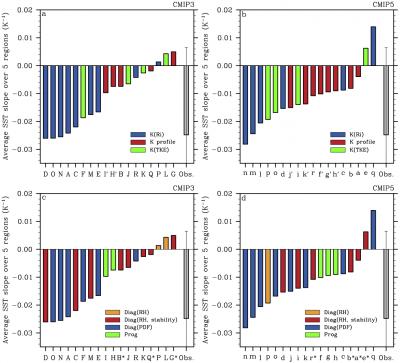Marine Low Cloud Cover is Likely to Decrease in the 21st Century
Changes in marine clouds play a large role in shaping the response to external forcing seen in climate simulations undertaken in recent decades. They also exhibit a large spread across models. A sizeable portion of the spread originates in the subtropical stratocumulus regions off the west coasts of continents. In these regions, simulated changes in low cloud cover (LCC) vary a great deal in size and magnitude across models. Simulated LCC changes in the stratocumulus regions are likely driven by changes in their large-scale environment. Many studies identify two thermodynamical variables as the most important large-scale controls on LCC. One is the strength of the inversion that caps the planetary boundary layer (PBL), measured by the estimated inversion strength (EIS). The other variable is sea surface temperature (SST). In this study, we assume simulated LCC changes in 18 climate models participating in phase 3 of the Coupled Model Intercomparison Project (CMIP3) and 18 climate models participating in phase 5 of the Coupled Model Intercomparison Project (CMIP5) can be interpreted as a linear combination of the contributions from all the controls. Accordingly, we develop a heuristic model designed to tease out each contribution. In this heuristic model, the contribution from each thermodynamical variable (EIS or SST) is quantified by the product of anthropogenic change in that variable and a local LCC sensitivity to it. We quantify the EIS and SST sensitivities informing the heuristic model based on interannual climate variability in the 20th-century. LCC changes not linearly attributable to either EIS or SST changes (the residual term) are then attributed to changes in other cloud-controlling factors. In this study, we also explore to what extent the intermodel spread in LCC changes are linked to differences in the models' PBL and cloud parameterizations.
Our heuristic model is remarkably skillful. Its SST term dominates, accounting for nearly two-thirds of the intermodel variance of LCC changes in CMIP3 models, and about half in CMIP5 models (see Figure 1). Of the two factors governing the SST term (the SST increase and the sensitivity of LCC to SST perturbations), the SST sensitivity drives the spread in the SST term and hence the spread in the overall LCC changes. This sensitivity varies a great deal from model to model and is strongly linked to the types of cloud and boundary layer parameterizations used in the models (see Figure 2). EIS and SST sensitivities are also estimated using observational cloud and meteorological data. The observed sensitivities are generally consistent with the majority of models as well as expectations from prior research. The observed EIS and SST slopes are comparable in magnitude, as are those of the models.
Based on the observed sensitivities and the relative magnitudes of simulated EIS and SST changes (which we argue are also physically reasonable), the heuristic model predicts LCC will decrease over the 21st century. However, to place a strong constraint, for example on the magnitude of the LCC decrease, will require longer observational records and a careful assessment of other environmental factors producing LCC changes. Meanwhile, addressing biases in simulated EIS and SST sensitivities will clearly be an important step towards reducing intermodel spread in simulated LCC changes.

